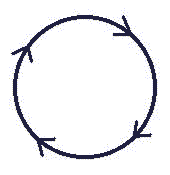3. LEVELS OF QUALIFICATION
3.1 There are three basic levels of qualification. These levels may be further subdivided by the employer for specific situations where additional levels of skills and responsibilities are deemed necessary.
3.2 While in the process of being qualified and certified to Level I, an individual should be considered a Trainee. A Trainee should work with a certified individual and shall not independently bake, conduct any tests, interpret or evaluate the results of a test, or report test results.
3.3 The three basic levels of qualification are as follows:
3.3.1 Level I -- A Level I individual should be qualified to properly perform specific calibrations, specific baking tasks, specific tests, and specific evaluations for acceptance or rejection determinations according to written instructions and to record results. The Level I shall receive the necessary instruction or supervision from a certified Level II or III individual.
3.3.2 Level II -- A Level II individual should be qualified to set up and calibrate equipment and to interpret and evaluate results with respect to applicable standards and specifications. The Level II should exercise assigned responsibility for on-the-job training and guidance of trainees and Level I personnel. The Level II should be able to report the results of evaluations.
3.3.3 Level III -- A Level III individual should be capable of establishing techniques and procedures; interpreting standards, specifications, and procedures; and designating the particular methods, techniques, and procedures to be used. The Level III should be responsible for the operations for which qualified and to which assigned, and should be capable of interpreting and evaluating results in terms of existing standards and specifications.
4. REQUIREMENTS
4.1 Ingredients -- Only those ingredients covered in the following sub-paragraphs shall be used in the preparation of toll house cookies. These ingredients shall meet the requirements of American Standard ASA TH100.1-1982 to be acceptable.
4.1.1 Flour (see 7.2.1) -- As one of the main ingredients in the toll house cookie, it is essential that the flour employed shall conform to the highest standards in color, texture, freshness, and content.
4.1.1.a Color -- The color shall be white. Tinted, tainted, or tan flour shall be unacceptable.
4.1.1.b Texture -- The texture shall be fluffy, not solidly packed. The flour shall be sifted prior to usage. Flour that is caked or lumpy such that it cannot be sifted is unacceptable.
4.1.1.c Freshness -- The flour shall either be fresh out of a heretofore unopened flour bag or fresh out of an airtight container in which it has been stored. Flour which has been exposed to the air for more than four (4) hours is unacceptable.
4.1.1.d Content -- For the purposes of this specification, flour must contain at least 99.8% blanched wheat flour. The remaining 0.2% may contain vitamins, minerals, and malted barley flour. It shall not be of the self-rising variety of flour.
4.1.2 Baking Soda -- Pure baking soda, also known as bicarbonate of soda, must be used.
4.1.2.a Purity -- Baking soda must not be diluted.
4.1.2.b Freshness -- Baking soda must be fresh out of covered box. Contents of opened boxes used to deodorize refrigerators are unacceptable.
4.1.2.c Terminology -- Assure that baking soda, not baking powder, is used.
4.1.3 Salt -- Iodized salt should be used, unless consumer is on a low-sodium diet, in which case a salt substitute is acceptable.
4.1.4 Butter -- A variety of products may be used to satisfy this requirement, including butter, margarine (also called oleo), or lard. The exact product chosen will depend on availability and the consumer's taste and budget. The original product may be in a stick, tub, or softened form. However, butter shall be softened prior to usage.
4.1.5 Sugar -- Two types of sugar are required by this specification: granulated white and brown. These differ in color and texture. However, equal quantities of both types of sugar must be used to assure that there is no discrimination, as required by the State Code of Anti-Discrimination CAD-1979. The resulting cookie will be well-integrated.
4.1.5.a Granulated white -- This must be a white, easy-to-pour sugar. Lumps and discolorations are unacceptable.
4.1.5.b Brown -- This sugar may be either light brown or dark brown. It must be firmly packed in the measuring device. Lumps are acceptable.
4.1.6 Vanilla extract -- It is recommended that pure vanilla extract (contents: H20, alcohol 35%, vanilla bean extractives, cane sugar) be used. However, the use of clear imitation vanilla (contents: H20, alcohol 35%, artificial flavor) may also be acceptable, providing that the resultant cookies are flavorful.
4.1.7 Water -- The H20, commonly called water, is acceptable for use if it is deemed safe and desirable to drink. Sulfur water or aquarium water, for example, is unacceptable.
4.1.8 Eggs -- The quality of the eggs used must be closely monitored for size, shape, shell, freshness, and contents.
4.1.8.a Size -- Of the four (4) common sizes of eggs (small, medium, large, and extra large), it is recommended that either medium or large be used.
4.1.8.b Shape -- Eggs must be ovate.
4.1.8.c Shell -- Eggshells may either be white or light brown, depending on personal preference. They should not contain dark spots. Shells may not be cracked by personnel other than those preparing toll house cookies.
4.1.8.d Freshness -- To determine freshness, eggs shall either be visually tested by verifying the date stamped on the carton, or tested by candling (5.3.1).
4.1.8.e Contents -- Eggs shall contain a "white" and a "yolk", the proportional size of which is determined by the grade of the product.
4.1.9 Chocolate Chips -- In order to make authentic Toll House Cookies, there is only one approved vendor of chocolate chips: Nestlés Semi-Sweet Chocolate Morsels. Other vendors of chocolate chips may only be used if the end result is just an ordinary chocolate chip cookie.
The quality of the Nestlés Semi-Sweet Chocolate Morsels is the responsibility of the vendor; however, personnel preparing Toll House Cookies should verify a dark brown color and a small size (approximately 1/8") of each morsel. Each morsel should be shaped thusly: .

4.1.10 Nuts -- Any variety of nuts may be used, provided that the nuts are shelled and coarsely chopped. Walnuts are one recommended variety.
4.2 Formulation -- It is critical to the preparation of toll house cookies to utilize the proper proportions of ingredients listed in paragraph 4.1 The proportions are shown on Table 4.2.
TABLE 4.2
FORMULATIONS


